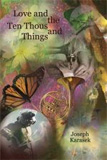Review by Arlan Hess
Tebot Bach
Box 7887
Huntington Beach, CA 92615-7887
ISBN 13 978-1-893670-39-6
2009, 74 pp., $15.00
www.tebotbach.org
“It is difficult to get news from poems, yet men die miserably every day for the lack of what is found there,” writes William Carlos Williams. In poems that embody the Imagist value of “clarity of expression through the use of precise visual images,” Dr. Williams allows his readers to experience with him birth, death and the journey that happens between the two; indeed, he was inspired to write “The Red Wheelbarrow” while looking out the window at the bedside of a dying child. Like Williams, Joseph Karasek writes clear, lyric poems in his new collection Love and the Ten Thousand Things (Tebot Bach 2009) thus demonstrating the antithesis of what Williams referred to when reproaching contemporary headlines. Love and the Ten Thousand Things is anything but soulless.
In poems that recall his youth in polyglot New York City, Karasek introduces the voices that influenced his professional career. In “old story,” a poem vaguely reminiscent of Roethke’s “My Papa’s Waltz,” a wife and mother in control of the purse strings expects her husband to work hard to bring home the potatoes. When the speaker’s father whistles a small tune through his hands, his wife admonishes in Yiddish, “Aleh Dos ein Leben macht nicht!” The speaker realizes there is a time and place for music, conceding, “She was right of course. All that / didn’t make a living.” In a later poem, the speaker later finds a more disciplined mentor in Dionysus Berardinelli, a crouched old man who teaches the musician how to bake bread and to play a sparing vibrato. In the poem “joy,” Karasek remembers, “in his eyes a far look; six years he said, / it’s time. The notes turned in a silk-like coil / and made as the bread is made // until the dough lost its rough edges– / Lightly, lightly he said / make contact lightly–.” On a walk beside a stream, Berardinelli puts passion and responsibility into context for the speaker, thus allowing him to see his work as part of a larger conversation between inspiration and nourishment.
Expansiveness also characterizes Karasek’s collection. Among pieces that weave together seasonal references with the patina of memory are poems employing a Zen-like caesura. Such pieces recall a breathy confusion upon rediscovering a lost sensation or the staccato beat of a practiced scale. In “12 tones,” for example, the silence of the prairie is compared to an empty hall after the musicians have gone home. All that’s left is the discarded evidence of what was, “a barrelful of noise. discarded candy wrappers,” and sound, like pain, is referred: “narcissus hears only echo, / above the river. / the river shudders.” The aural imagery of Karasek’s poetry becomes a palette, as it were, of emotional landscape where silence fills in the gaps between awareness.
This silence is practiced not only between lines but also among poems. Titles of pieces within certain sections form lines of a larger poem, a grander conversation that structures the complete opus. For example, the titles of section one can be read as “drift / saturdays / the sea, remote / today it rained / it is the heart, the living / focal point / straight up & breathe / these horns of endless breath / the bridge.” From the start, Karasek roots the reader in time and place, both physically and emotionally, like his old counselor taught him, “Lightly, lightly.” This discourse continues in section three: “occasional car / tin poets in the sink, a pail on the side– / photo in black & white, 1933 / the ocean projects its memory / before breakfast / love and the ten thousand things / joy / if I cross that bridge eventually / the visit / his trouser legs falling over his shoes.” Here, the last poem in the section recalls Prufrock and his rolled trousers, yet in Karasek’s work, an old man sits beside the sea in his wheelchair remembering “times when he walked among them / listening to the stalk, listening to the whistle.” Rather than the speaker filling the poem with a cacophony of noise, the poet allows the ambient sound of his life to speak for him. His silent reflection speaks volumes.
Love and the Ten Thousand Things finds Karasek redefining the Imagists on his own, distinctly twenty-first century terms. Experimenting with meter and lineation, the poet is full of nostalgia, learned strength and hard-fought personal satisfaction. Featuring urban, ocean and musical imagery, the collection is a snapshot of Karasek’s life. Like Williams, Roethke and Eliot, Karasek invites the reader to experience his journey from childhood to maturity and the struggle for survival that exists between the two.